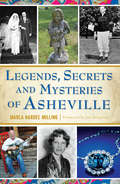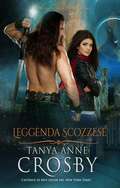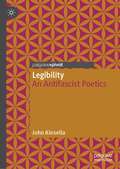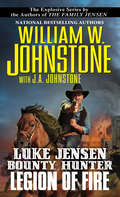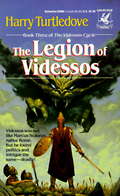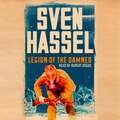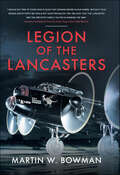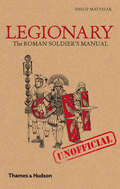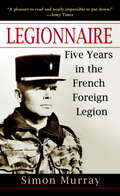- Table View
- List View
Legends, Lore and True Tales of Utah (American Legends)
by Lynn AraveLegends, Lore and True Tales of Utah explores an eclectic pastOrdinary history books often fail to address the obscure or the unexplained, leaving questions buried in annals of yesteryear. Where were Utah's mythical monsters, including Bigfoot, spotted? How did 'Schoolmarm's Bloomers' become a state symbol? What created the Lagoon Amusement Park's 'dark side'? Why did 'Frankenstein' prowl through the Cache town of Clarkston? Does Sardine Canyon hide the state's fishiest story? Exactly what was the 'Lakemobile' that rolled through the Great Salt Lake? When and why did BYU temporarily ban football? How is it that the first college basketball team to ever play in the state was all women, and they beat the men? Retired journalist Lynn Arave presents this unique collection, including over a hundred photographs, of the Beehive State's offbeat history.
Legends, Secrets and Mysteries of Asheville
by Marla Hardee Milling Foreword By SchochetBeyond the beaten path of local landmarks, residents and tourists can find curious secrets, lost mysteries and fascinating legends. The famed Hope Diamond once found itself, and its mysterious curse, buried in an Asheville girl’s sandbox. Elvis once handed a cherished guitar to a local man at an Asheville concert, and he held on to it for forty years. At a flea market, an Asheville attorney paid a few bucks for an old tintype likely of Billy the Kid, and it may be worth millions. Native author Marla Hardee Milling recounts odd, but true, stories hiding behind Asheville’s picturesque beauty.
Leggenda Scozzese
by Tanya Anne Crosby Elisabetta Bricca2014 Annie Ross ha trascorso tutta la sua vita sentendosi persa, ma sta per intraprendere un viaggio che la riporterà indietro nel tempo - nell'878 d.C - dove l'attende l'arduo compito di Guardiana della Pietra del Destino e quello di ristabilire l'autorità di un potente capoclan Scozzese. Riuscirà a conquistare anche il cuore di Callum? Tanya Anne Crosby torna alle origini della leggenda stessa, a un tempo dove la magia era potente e i Pitti destinati a scomparire negli oscuri meandri della storia delle Highlands.
Legibility: An Antifascist Poetics (Modern and Contemporary Poetry and Poetics)
by John KinsellaThis Pivot book provides a wide-ranging and diverse commentary on issues of legibility (and illegibility) around poetry, antifascist pacifist activism, environmentalism and the language of protest. A timely meditation from poet John Kinsella, the book focuses on participation in protest, demonstration and intervention on behalf of human rights activism, and writing and acting peacefully but persistently against tyranny. The book also examines how we make records and what we do with them, how we might use poetry to act or enact and/or to discuss such necessities and events. A book about community, human and animal rights and the way poetry can be used as a peaceful and decisive means of intervention in moment of public social and environmental crisis. Ultimately, it is a poetics against fascism with a focus on the well-being of the biosphere and all it contains.
Legible Religion
by Duncan MacraeScholars have long separated a few privileged "religions of the Book" from faiths lacking sacred texts, including ancient Roman religion. Looking beyond this distinction, Duncan MacRae delves into Roman treatises on the nature of gods and rituals to grapple with a central question: what was the significance of books in a religion without scripture?
Legion (Raven and the Eagle series)
by Geraint JonesBattle, plunder, and glory awaitThe eagerly anticipated prequel series to Blood Forest (Ambush) and Siege.AD 6: The greatest army assembled in a generation prepares to march.But not Legionary Corvus. He and half his legion are to be left behind to garrison the province of Pannonia: a wild place where the mountains are as deadly as any foe.Corvus despairs as he watches his closest friend Marcus march to war, not knowing that his own eager thirst for battle is about to be quenched. A huge rebel army has revolted against the Empire, and Corvus and his few comrades are all that stand against them…A gritty historical adventure, perfect for fans of Ben Kane and Simon Scarrow.Praise for Geraint Jones‘Outstanding… Geraint’s own military service has helped create a realistic and gritty vision of what it was like to be a soldier in Roman times. Bold, violent, but also deeply introspective, this book offers insight not only into history, but also the mind of the soldier. I couldn’t put it down’ Steven Pressfield, author of Gates of Fire‘Blood and guts, but also a clever exploration of the moral ambiguity of war and loyalty to a flag’ Mail on Sunday‘Brutal, audacious, and fast paced’ Anthony Riches, author of the Empire series.‘Historical fiction written by a real war veteran who knows all there is to know about blood and bonding in battle’ Weekend Sport
Legion of Fire: Legion Of Fire (Luke Jensen Bounty Hunter #6)
by William W. Johnstone J.A. JohnstoneLuke Jensen&’s got an outlaw gang in his sights. Sharp-shooting Western adventure from the bestselling authors of the Preacher & MacCallister series. Johnstone Country. Frontier Spirit Lives Here.Luke Jensen comes from a righteous brood. Survival is in his blood. And he&’s burned enough gunpowder to forge out his own legend on the frontier as the toughest bounty hunter who ever stalked his prey . . . THE HUNTING PARTY When Luke Jensen traps fugitive Ben Craddock in Arapaho Springs, he&’s ready to collect on his bounty. But the job&’s not done—not by a long shot. A raid by a savage gang known as the Legion of Fire has left the peaceful settlement looted, burned to the ground, and the ashes scoured for female hostages—including the marshal&’s daughter. For Luke this is more than a hunt. It&’s now a rescue. And with Craddock busted out of jail and thrown in with the gang, it&’s also revenge. Wrangling a small posse, Luke heads for the Legion&’s hideout in the Kansas badlands. Outnumbered, they can&’t risk an ambush. Instead, it&’s going to take cutthroat cunning for the outlaws of the Legion of Fire to go down in flames—one by one. Praise for the novels of William W. Johnstone &“[A] rousing, two-fisted saga of the growing American frontier.&”—Publishers Weekly on Eyes of Eagles &“There&’s plenty of gunplay and fast-paced action as this old-time hero proves again that a steady eye and quick reflexes are the keys to survival on the Western frontier.&”—Curled Up with a Good Book on Dead Before Sundown
Legion of Videssos
by Harry TurtledoveSince the Roman legion had been mysteriously transported to this world of magic, tribune Marcus Scaurus had served the rulers of war-torn Videssos well. He had been largely responsible for ousting the Pretender and putting Thorish Gavras on the throne. That, of course, made him a hero.Rome or Videssos, however, Fortune was a fickle goddess.Now he and the legion were returning in triumph to Videssos the city after defeating a well-entrenched army of rebel mercenaries. But Marcus, betrayed by the one closest to him, was returning to be seized, dragged before the Emperor, and questioned under truth-drug like a traitor.Of the court, only Alypia Gavra stuck by him -- but consorting with the Emperor's niece was dangerous. It could lead to exile -- or death!Yet Alypia was attractive. And Marcus was lonely . . .From the Paperback edition.
Legion of the Brave
by D. P. RamachandranSights and sounds of a glorious fortnight - tank pennants fluttering in the wild amidst the dust and fury of the battle, the gleam of the bayonets and the echo of the battle-cry as a barrage was laid ...... Bangladesh, 1971, a legend is born.
Legion of the Damned (Sven Hassel War Classics)
by Sven HasselAn extraordinary book, which has captured the attention of all of Europe' - NEW YORK TIMES'LEGION OF THE DAMNED is an incredible picture of totalitarianism, of stupefying injustice ... He is graphic, at times brilliantly so, but never brutal or bitter. He is, too, a first-rate storyteller' - WASHINGTON POSTConvicted of deserting the German army, Sven Hassel is sent to a penal regiment on the Russian Front. He and his comrades are regarded as expendable, cannon fodder in the battle against the implacable Red Army. Outnumbered and outgunned, they fight their way across the frozen steppe...This iconic anti-war novel is a testament to the atrocities suffered by the lone soldier in the fight for survival.Sven Hassel's unflinching narrative is based on his own experiences in the German Army. He began writing his first novel, LEGION OF THE DAMNED in a prisoner of war camp at the end of the Second World War.Read by Rupert Degas(p) 2014 Orion Publishing Group
Legion of the Lancasters
by Martin W. BowmanSöthe had already decided to use his nose armament against the 4-mot [four engined bomber]. He looked out and focused on a black shape of the Britisher. Small, bluish exhaust flames made it easier to keep the target in sight. Four engines, twin tail were recorded almost subconsciously. No sudden movement that might attract their attention. Calm now! Guns armed? Night sight switched on? Everything OK! Now he could see that it was a Lancaster, crossing gently from starboard to port. He applied a little more power and approached cautiously. Now he was exactly behind him at about 100 metres’ range. The rear turret was clearly recognisable. Brönies kept silent. ‘Pauke! Pauke!’ [‘Kettledrums! Kettledrums!’] Söthe announced with a cry. Brönies immediately transmitted ‘Ich beruhe’. Then they closed in rapidly for the kill. One can almost smell the flak, taste the cordite and experience the nervous ‘twitch’ before jumping out of one’s skin to the sound of exploding shells and detonating bombs in this pulsating and highly intriguing selection of never-before-told stories recalled largely by members of the revered Lancaster crews of RAF Bomber Command. From this bomber’s introduction into service in 1942 with the famous if flawed raid on Augsburg on 17 April that year, to the attacks on the Tirpitz in 1944, each chapter is a tribute to the spirit of those who flew the ‘Lanc’ in anger and gained the respect of their enemies.
Legion of the Lost
by Jaime SalazarThe son of underpaid Mexican immigrants, Jaime earned a degree in mechanical engineering from Purdue. But at twenty-three, he was disillusioned with the corporate fast track. So he became an outcast American in a hard-bitten group of recruits-men on the run from their pasts, men without hope: He joined the French Foreign Legion. From the Legion's notoriously brutal training to Salazar's fierce competitiveness, ultimate disillusionment and dramatic desertion, Legion of the Lost is a compelling, firsthand account of today's French Foreign Legion that will dispel myths while adding to the legend of the finest trained army of warriors the world has ever known.
Legionary: The Roman Soldier's (Unofficial) Manual
by Philip MatyszakAn insider's guide: how to join the Roman legions, wield a gladius, storm cities, and conquer the world Your emperor needs you for the Roman army! The year is AD 100 and Rome stands supreme and unconquerable from the desert sands of Mesopotamia to the misty highlands of Caledonia. Yet the might of Rome rests completely on the armored shoulders of the legionaries who hold back the barbarian hordes and push forward the frontiers of empire. This carefully researched yet entertainingly nonacademic book tells you how to join the Roman legions, the best places to serve, and how to keep your armor from getting rusty. Learn to march under the eagles of Rome, from training, campaigns, and battle to the glory of a Roman Triumph and retirement with a pension plan. Every aspect of army life is discussed, from drill to diet, with handy tips on topics such as how to select the best boots or how to avoid being skewered by enemy spears. Combining the latest archaeological discoveries with the written records of those who actually saw the Roman legions in action, this book provides a vivid picture of what it meant to be a Roman legionary.
Legionnaire: Five Years in the French Foreign Legion
by Simon MurraySimon Murray was nineteen when he joined the French Foreign Legion. Inspired by the romantic myths of Beau Geste, he found himself in the ranks of one of the world's greatest - and toughest - fighting forces. He kept a unique diary of the hard living, harsh discipline, and the military tradition of 'March or Die' which he turned into this gripping book. 'Simon Murray's personal account of a gently reared, well-educated British youth's coming of age in the French Foreign Legion has the drama, excitement and colour of a good guts-and-glory thriller ... Murray is a talented storyteller, and his fellow legionnaires and their disciplined and proud Corps are vividly portrayed. I was hooked from the first page.' Dr. Henry Kissinger. 'One of the greatest adventure stories in recent years.' Chris Patten.
Legions of Pigs in the Early Medieval West (Yale Agrarian Studies Series)
by Jamie KreinerAn exploration of life in the early medieval West, using pigs as a lens to investigate agriculture, ecology, economy, and philosophy In the early medieval West, from North Africa to the British Isles, pigs were a crucial part of agriculture and culture. In this fascinating book, Jamie Kreiner examines how this ubiquitous species was integrated into early medieval ecologies and transformed the way that people thought about the world around them. In this world, even the smallest things could have far†‘reaching consequences. Kreiner tracks the interlocking relationships between pigs and humans by drawing on textual and visual evidence, bioarchaeology and settlement archaeology, and mammal biology. She shows how early medieval communities bent their own lives in order to accommodate these tricky animals—and how in the process they reconfigured their agrarian regimes, their fiscal policies, and their very identities. In the end, even the pig’s own identity was transformed: at the close of the early Middle Ages, it had become a riveting metaphor for Christianity itself.
Legions of Rome
by Stephen Dando-CollinsNo book on Roman history has attempted to do what Stephen Dando-Collins does in Legions of Rome: to provide a complete history of every Imperial Roman legion and what it achieved as a fighting force. The author has spent the last thirty years collecting every scrap of available evidence from numerous sources: stone and bronze inscriptions, coins, papyrus and literary accounts in a remarkable feat of historical detective work.The book is divided into three parts: Part 1 provides a detailed account of what the legionaries wore and ate, what camp life was like, what they were paid and how they were motivated and punished. The section also contains numerous personal histories of individual soldiers. Part 2 offers brief unit histories of all the legions that served Rome for 300 years from 30BC. Part 3 is a sweeping chronological survey of the campaigns in which the armies were involved, told from the point of view of particular legions.Lavish, authoritative and beautifully produced, Legions of Rome will appeal to ancient history enthusiasts and military history buffs alike.
Legions of Rome: The definitive history of every Roman legion
by Stephen Dando-CollinsNo book on Roman history has attempted to do what Stephen Dando-Collins does in Legions of Rome: to provide a complete history of every Imperial Roman legion and what it achieved as a fighting force. The author has spent the last thirty years collecting every scrap of available evidence from numerous sources: stone and bronze inscriptions, coins, papyrus and literary accounts in a remarkable feat of historical detective work. The book is divided into three parts: Part 1 provides a detailed account of what the legionaries wore and ate, what camp life was like, what they were paid and how they were motivated and punished. The section also contains numerous personal histories of individual soldiers. Part 2 offers brief unit histories of all the legions that served Rome for 300 years from 30BC. Part 3 is a sweeping chronological survey of the campaigns in which the armies were involved, told from the point of view of particular legions. Lavish, authoritative and beautifully produced, Legions of Rome will appeal to ancient history enthusiasts and military history buffs alike.
Legions of Rome: The definitive history of every Roman legion
by Stephen Dando-CollinsNo book on Roman history has attempted to do what Stephen Dando-Collins does in Legions of Rome: to provide a complete history of every Imperial Roman legion and what it achieved as a fighting force. The author has spent the last thirty years collecting every scrap of available evidence from numerous sources: stone and bronze inscriptions, coins, papyrus and literary accounts in a remarkable feat of historical detective work. The book is divided into three parts: Part 1 provides a detailed account of what the legionaries wore and ate, what camp life was like, what they were paid and how they were motivated and punished. The section also contains numerous personal histories of individual soldiers. Part 2 offers brief unit histories of all the legions that served Rome for 300 years from 30BC. Part 3 is a sweeping chronological survey of the campaigns in which the armies were involved, told from the point of view of particular legions. Lavish, authoritative and beautifully produced, Legions of Rome will appeal to ancient history enthusiasts and military history buffs alike.
Legislating Authority: Sin and Crime in the Ottoman Empire and Turkey
by Ruth MillerLegislation Authority addresses issues of law, state violence, and state authority within the Ottoman and Turkish context.
Legislating Instability: Adam Smith, Free Banking, and the Financial Crisis of 1722
by Tyler Beck GoodspeedFrom 1716 to 1845 Scottish banks were among the most dynamic and resilient in Europe, effectively absorbing economic shocks that rocked markets in London and on the continent. Tyler Beck Goodspeed explains the paradox that Scotland’s banking system achieved this success without the regulations Adam Smith considered necessary for economic stability.
Legislating The Holocaust
by Karl SchleunesFrom April 1933 to early 1943, Bernard Loesener served as the official "Jewish Expert" in the German Third Reich's Ministry of the Interior, the government body responsible for the Nazi's legislative assault on German Jewry. In that role, he personally drafted much of the legislation, the Nuremberg Laws of 1935 preeminently, that gradually dispossessed, disenfranchised, and dehumanized the Jews of Nazi Germany. During the first six years of Nazi rule, the seminal period of government-sponsored anti-Semitism, Loesener kept the minutes of many crucial, high-level, inter-ministerial conferences concerned with the "Jewish Question." As observer and participant, his experiences were virtually unparalleled. In 1950, Loesener penned a memoir that sought to explain, and justify, his actions during the ten-year escalation of Nazi oppression that resulted, to Loesener's professed horror, in the Final Solution. It was published in 1961, in German, by the journal Vierteljahrshefte fuer Zeitgeschichte. It has never before appeared in English, until now - in Legislating the Holocaust.
Legislating The Holocaust: The Bernhard Loesenor Memoirs And Supporting Documents
by Karl SchleunesFrom April 1933 to early 1943, Bernard Loesener served as the official ?Jewish Expert? in the German Third Reich's Ministry of the Interior, the government body responsible for the Nazi's legislative assault on German Jewry. In that role, he personally drafted much of the legislation, the Nuremberg Laws of 1935 preeminently, that gradually dispossessed, disenfranchised, and dehumanized the Jews of Nazi Germany. During the first six years of Nazi rule, the seminal period of government-sponsored anti-Semitism, Loesener kept the minutes of many crucial, high-level, inter-ministerial conferences concerned with the ?Jewish Question.? As observer and participant, his experiences were virtually unparalleled. In 1950, Loesener penned a memoir that sought to explain, and justify, his actions during the ten-year escalation of Nazi oppression that resulted, to Loesener's professed horror, in the Final Solution. It was published in 1961, in German, by the journal Vierteljahrshefte fuer Zeitgeschichte. It has never before appeared in English, until now - in Legislating the Holocaust.
Legislating the Holocaust: The Bernhard Loesener Memoirs and Supporting Documents
by Karl A. SchleunesFrom April 1933 to early 1943, Bernard Loesener served as the official "Jewish Expert" in the German Third Reich's Ministry of the Interior, the government body responsible for the Nazi's legislative assault on German Jewry. In that role, he personally drafted much of the legislation, the Nuremberg Laws of 1935 preeminently, that gradually dispossessed, disenfranchised, and dehumanized the Jews of Nazi Germany. During the first six years of Nazi rule, the seminal period of government-sponsored anti-Semitism, Loesener kept the minutes of many crucial, high-level, inter-ministerial conferences concerned with the "Jewish Question. " As observer and participant, his experiences were virtually unparalleled. In 1950, Loesener penned a memoir that sought to explain, and justify, his actions during the ten-year escalation of Nazi oppression that resulted, to Loesener's professed horror, in the Final Solution. It was published in 1961, in German, by the journal Vierteljahrshefte fuer Zeitgeschichte. It has never before appeared in English, until now - in Legislating the Holocaust.
Legislative Effectiveness in the United States Congress
by Craig Volden Alan E. WisemanThis book explores why some members of Congress are more effective than others at navigating the legislative process and what this means for how Congress is organized and what policies it produces. Craig Volden and Alan E. Wiseman develop a new metric of individual legislator effectiveness (the Legislative Effectiveness Score) that will be of interest to scholars, voters, and politicians alike. They use these scores to study party influence in Congress, the successes or failures of women and African Americans in Congress, policy gridlock, and the specific strategies that lawmakers employ to advance their agendas.
Legislator Success in Fragmented Congresses in Argentina
by Ernesto Calvo"Plurality-led Congresses are among the most pervasive and least studied phenomena in presidential systems around the world. Often conflated with divided government, where an organized opposition controls a majority of seats in congress, plurality-led congresses are characterized by a party with fewer than 50 percent of the seats still in control of the legislative gates. Extensive gatekeeping authority without plenary majorities, this book shows, leads to policy outcomes that are substantially different from those observed in majority-led congresses. Through detailed analyses of legislative success in Argentina and Uruguay, this book explores the determinants of law enactment in fragmented congresses. It describes in detail how the lack of majority support explains legislative success in standing committees, the chamber directorate, and the plenary floor"--

